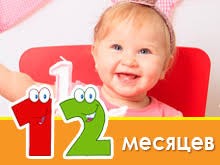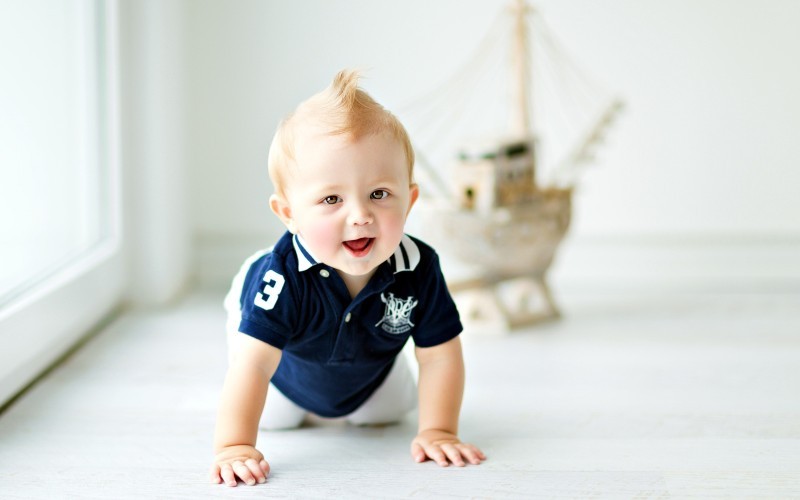The first year of the child's life is coming to an end. Anthropometric dynamics over the past twelve months is colossal! Do you remember well what this pink delicate creation looked like three hundred and sixty-five days ago? The achievements of the child during this time are amazing and huge! Kroha grew by 25 centimeters and gained about 7 kilograms of body weight from the moment of birth! Already six or eight teeth in the arsenal of a small man! Is not it an achievement - the skill of conquering space ?!
At this stage, differences in the motor development of babies persist. Little researchers crawl a lot and confidently, leaning on their hands and knees. The more dexterous children walk alone or holding hands with an adult or furniture. The baby begins to develop control of his own movements, he tries to keep his balance with one hand, in order to keep the toy in the other. The child sitting on the floor does not lose his balance even when you lift his leg (for example, putting on his shoes).
The movements of the hand also become more coordinated. Trying to capture several objects at the same time, the baby opens the palm according to their size. Developed by the combined movements of both hands: the child can take toys at the same time with both hands. There is a "plucked grip" - the child grabs small objects and toys with a bent thumb and index finger. The kid gradually learns to be more independent - he eats a biscuit or drying, tries to drink from a cup, keep a spoon.
The child begins to comprehend spatial relationships. He likes to take toys out of boxes and cans. It is not always possible to fold objects back from the baby. It is difficult for him to understand how to put one object into another. This is especially noticeable if you give the baby two round shapes - large and small. Instead of investing a small form in a large one, he tries to put big into small and makes repeated attempts to achieve the desired result.
Mastering the first steps, the kid learns to perform one-time other actions: pushing a toy on wheels in front of him, carrying an object in one or two hands, pulling the machine on a string. Kids who started walking for a year continue to learn new movements-they want to squat, lodge without the help of an adult, throw and roll the ball and follow the look behind his movement.

Kids begin to discover new patterns for themselves - they understand that the toy hidden in their eyes does not disappear, but remains in the same place where it was hidden. The child closely follows your hand when you hide a toy, and immediately looks for it where you put it. Hide the cube under a small box - the kid will lift the box, take a cube and, satisfied with himself, will show it to you.
At this age, babies can begin to learn simple manipulations with toys - pull the machine to him by the string, put the bear "to sleep" in the crib next to him. Children continue to learn the unknown. In this case, the ways to explore new objects remain old: the child shakes, knocks and pulls into his mouth and is edible and inedible. He can try to bite a toy that looks like a fruit that he has recently tried. Feeling and touching various subjects, the baby can show you that not all tactile sensations are pleasant to him. Some babies at this age may have an increased tactile sensitivity: they do not like to touch jelly or damp soft objects, stand barefoot on the sand, etc. The child, indisputably, needs a different tactile experience, but with new sensations acquaint him gradually. Allow the baby to walk barefoot as much as possible on different surfaces: on the floor, on grass and sand, wet and dry. Touch up to the back and handles of the baby with a soft puff, pieces of fur, warm and cool objects. His favorite game for a long time is the game "comes in and out." It is not by chance that children's psychologists call this age of the child the age of "Eeyore". Kids can spend hours in storage items in the tank, and then get them from there.
The child becomes more sociable and with pleasure meets already familiar adults, is happy to meet with them and strives to be at the center of events. He needs more and more variety. The games of the baby become more meaningful. During this period it is good to allocate a special time for games with him. It is very important that the father plays with the child as often as possible. The games of dads and moms are different. Dads play with the kids in "noisy" games, lift them up, throw up, they teach you to kick the ball.
Many babies show increasing interest in viewing pictures in books. This does not prevent them from using the book as a toy: the kid twists the book, knocks it on the floor, pulls at the pages. That's why the first books for kids should be the small format, light, with cardboard pages. Buy picture books without text. Do not prevent the child from playing with the book. Vivid pictures necessarily draw his attention. Show the child images of familiar objects. Loudly call them, read short rhymes.
The child requires more attention from the parents. He wants to communicate and is looking for the means of communication available to him. The kid develops a system of sound accompaniment of his requests understandable to his parents - by the sounds and gestures of impatience expresses the desire to drink, is, by an expressive gesture expresses the desire to get a toy or an object of interest.
The child learns to pronounce new sounds and actively trains in their pronunciation. He can pronounce individual sounds and sound combinations repeated syllables ("ma-ma", "pa-pa", "ba-ba") which some children become the first words. At this age, some children can utter the first word. What is the difference between a combination of sounds and a word? The word always refers to a particular person, object or action. The combinations of sounds, unlike words, are pronounced by themselves, "to nowhere," and do not carry a semantic load. You notice that, without knowing how to speak, the child understands much: not only words but also phrases. At the request of my mother or father, the baby wags a pen: "bye-bye", claps his hands, ceases to take any action, reacting to the prohibition of parents. The number of words a child understands is significantly greater than the set of words that he can pronounce. The kid understands and fulfills simple requests: "give me", "show me", "get the ball". A crumb shows, when he is called by name, looks toward his parents if they are spoken about. He begins to understand the word "no", but does not always react to the ban, for example, for some time, he stops doing what his parents do not like, then to continue again.
We list the toys and objects useful for the development of kids of this age: toys-nests (the principle of nesting dolls), pyramids and toys with rod-mounted parts, cubes, toys with slots, clockwork toys (cars, chickens, ducklings), toys with a long handle, dolls, soft and rubber toys-animals, sets of children's dishes, musical toys, dolls, inlaid frames.

